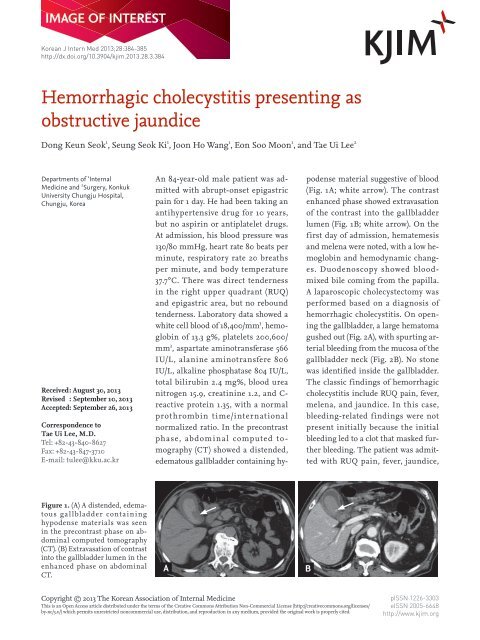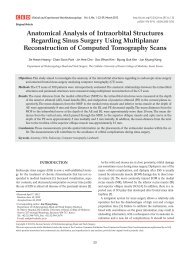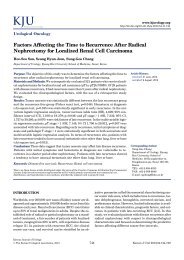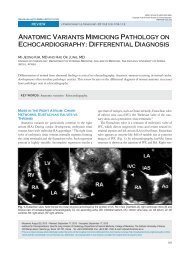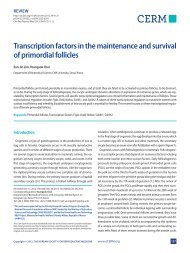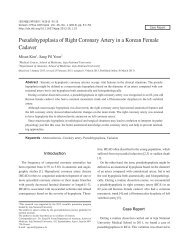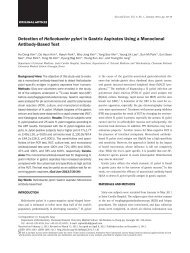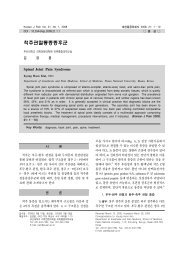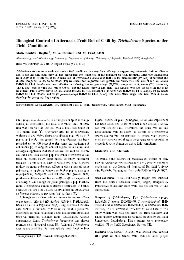PDF (1.06 MB) - KoreaMed Synapse
PDF (1.06 MB) - KoreaMed Synapse
PDF (1.06 MB) - KoreaMed Synapse
You also want an ePaper? Increase the reach of your titles
YUMPU automatically turns print PDFs into web optimized ePapers that Google loves.
IMAGE OF INTEREST<br />
Korean J Intern Med 2013;28:384-385<br />
http://dx.doi.org/10.3904/kjim.2013.28.3.384<br />
Hemorrhagic cholecystitis presenting as<br />
obstructive jaundice<br />
Dong Keun Seok 1 , Seung Seok Ki 1 , Joon Ho Wang 1 , Eon Soo Moon 1 , and Tae Ui Lee 2<br />
Departments of 1 Internal<br />
Medicine and 2 Surgery, Konkuk<br />
University Chungju Hospital,<br />
Chungju, Korea<br />
Received : August 30, 2013<br />
Revised : September 10, 2013<br />
Accepted : September 26, 2013<br />
Correspondence to<br />
Tae Ui Lee, M.D.<br />
Tel: +82-43-840-8627<br />
Fax: +82-43-847-3710<br />
E-mail: tulee@kku.ac.kr<br />
An 84-year-old male patient was admitted<br />
with abrupt-onset epigastric<br />
pain for 1 day. He had been taking an<br />
antihypertensive drug for 10 years,<br />
but no aspirin or antiplatelet drugs.<br />
At admission, his blood pressure was<br />
130/80 mmHg, heart rate 80 beats per<br />
minute, respiratory rate 20 breaths<br />
per minute, and body temperature<br />
37.7°C. There was direct tenderness<br />
in the right upper quadrant (RUQ)<br />
and epigastric area, but no rebound<br />
tenderness. Laboratory data showed a<br />
white cell blood of 18,400/mm 3 , hemoglobin<br />
of 13.3 g%, platelets 200,600/<br />
mm 3 , aspartate aminotransferase 566<br />
IU/L, alanine aminotransfere 806<br />
IU/L, alkaline phosphatase 804 IU/L,<br />
total bilirubin 2.4 mg%, blood urea<br />
nitrogen 15.9, creatinine 1.2, and C-<br />
reactive protein 1.35, with a normal<br />
prothrombin time/international<br />
normalized ratio. In the precontrast<br />
phase, abdominal computed tomography<br />
(CT) showed a distended,<br />
edematous gallbladder containing hypodense<br />
material suggestive of blood<br />
(Fig. 1A; white arrow). The contrast<br />
enhanced phase showed extravasation<br />
of the contrast into the gallbladder<br />
lumen (Fig. 1B; white arrow). On the<br />
first day of admission, hematemesis<br />
and melena were noted, with a low hemoglobin<br />
and hemodynamic changes.<br />
Duodenoscopy showed bloodmixed<br />
bile coming from the papilla.<br />
A laparoscopic cholecystectomy was<br />
performed based on a diagnosis of<br />
hemorrhagic cholecystitis. On opening<br />
the gallbladder, a large hematoma<br />
gushed out (Fig. 2A), with spurting arterial<br />
bleeding from the mucosa of the<br />
gallbladder neck (Fig. 2B). No stone<br />
was identified inside the gallbladder.<br />
The classic findings of hemorrhagic<br />
cholecystitis include RUQ pain, fever,<br />
melena, and jaundice. In this case,<br />
bleeding-related findings were not<br />
present initially because the initial<br />
bleeding led to a clot that masked further<br />
bleeding. The patient was admitted<br />
with RUQ pain, fever, jaundice,<br />
Figure 1. (A) A distended, edematous<br />
gallbladder containing<br />
hypodense materials was seen<br />
in the precontrast phase on abdominal<br />
computed tomography<br />
(CT). (B) Extravasation of contrast<br />
into the gallbladder lumen in the<br />
enhanced phase on abdominal<br />
CT.<br />
A<br />
B<br />
Copyright © 2013 The Korean Association of Internal Medicine<br />
This is an Open Access article distributed under the terms of the Creative Commons Attribution Non-Commercial License (http://creativecommons.org/licenses/<br />
by-nc/3.0/) which permits unrestricted noncommercial use, distribution, and reproduction in any medium, provided the original work is properly cited.<br />
pISSN 1226-3303<br />
eISSN 2005-6648<br />
http://www.kjim.org
seok dk, et al. Hemorrhagic cholecystitis<br />
A<br />
B<br />
Figure 2. (A) A large clot gushed out and (B) spurting arterial bleeding from the gallbladder neck was observed.<br />
leukocytosis, and abnormal liver functions consistent<br />
with obstructive jaundice. Hemobilia should be diagnosed<br />
quickly because angiography with embolization<br />
or emergency surgery is needed to prevent death.<br />
Fortunately, in this case, hemorrhagic cholecystitis<br />
presenting with obstructive jaundice on admission<br />
was diagnosed based on the typical findings of active<br />
bleeding on enhanced abdominal CT. A laparoscopic<br />
cholecystectomy was successful. The patient was discharged<br />
in good condition on postoperative day 14.<br />
Conflict of interest<br />
No potential conflict of interest relevant to this article<br />
is reported.<br />
http://dx.doi.org/10.3904/kjim.2013.28.3.384<br />
www.kjim.org<br />
385


